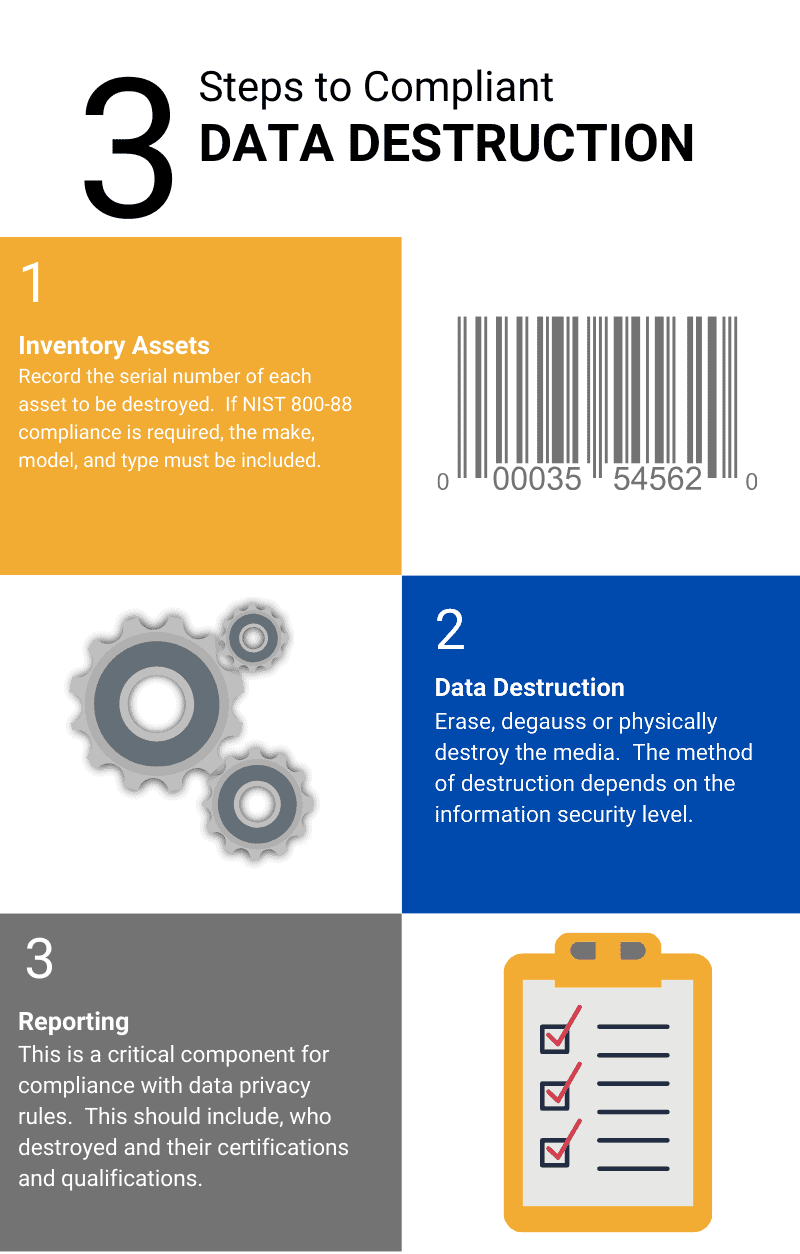Understanding the Role of Data Destruction in Strengthening Cyber Security Defenses
Understanding the Role of Data Destruction in Strengthening Cyber Security Defenses
Blog Article
The Relevance of Effective Information Destruction Practices in Safeguarding Sensitive Info and Ensuring Computer Safety
In an era where data violations are progressively usual, the value of efficient data destruction techniques can not be overstated. Applying robust data devastation techniques not just reduces these risks but also lines up with lawful compliance requirements, making certain that companies support their track record and foster client trust.
Understanding Information Damage
Comprehending information devastation is important in today's digital landscape, where sensitive details can quickly be endangered. Efficient data damage entails not merely deleting documents but guaranteeing that information is irretrievable with extensive approaches. This process is essential for companies that handle private client info, intellectual property, or inner records, as any kind of violation can cause extreme monetary and reputational effects.
Data destruction includes numerous strategies, consisting of shredding physical media, degaussing magnetic storage gadgets, and employing software-based solutions that overwrite information multiple times. Each technique offers a certain objective and should straighten with the sensitivity of the info being thrown away. For instance, physical destruction is often preferred for hard disks containing very personal information, while software program techniques may suffice for less delicate information.
Moreover, sticking to market requirements and guidelines, such as the General Data Defense Guideline (GDPR) or the Health Insurance Transportability and Responsibility Act (HIPAA), is necessary for compliance and to reduce legal threats. Organizations should develop a robust information devastation policy, train workers on best methods, and on a regular basis audit their treatments to guarantee that all sensitive details is thrown away securely and effectively.
Dangers of Inadequate Practices
Poor data devastation techniques subject organizations to significant dangers that can have far-reaching effects. When delicate details is not properly disposed of, it stays vulnerable to unauthorized gain access to, which can lead to information violations and identity burglary. Such incidents not just jeopardize the safety and security of people but likewise stain the organization's online reputation, leading to a loss of consumer trust and possible financial consequences.
Moreover, regulative conformity is increasingly rigid in several markets. Failing to comply with information destruction guidelines can lead to hefty fines and lawful activities versus companies. These penalties can strain monetary sources and draw away interest from core organization operations.
Additionally, the misuse of residual information can bring about intellectual property theft or corporate espionage, endangering competitive benefits (data destruction). The influence of inadequate data destruction prolongs beyond immediate monetary losses; it can likewise lead to long-lasting damages to brand name stability and market setting

Organizations have to recognize that information security is not solely about preventing breaches; it additionally incorporates the liable monitoring of information throughout its lifecycle. Ignoring reliable information damage protocols can have devastating implications, underscoring the necessity for durable actions to mitigate these dangers.
Ideal Practices for Data Damage
Carrying out reliable data damage practices is essential for guarding sensitive info and keeping conformity with regulative criteria. Organizations ought to adopt a multi-faceted technique to make certain that data is irretrievable, therefore protecting against unapproved gain access to and prospective violations.
First, information must be classified based upon level of sensitivity, enabling organizations to use suitable destruction approaches tailored to the degree of danger. For digital data, utilizing software-based data-wiping devices that conform with industry requirements can successfully overwrite existing data. Physical damage methods, such as shredding or degaussing, are critical for gadgets that save sensitive information, ensuring total eradication.
Developing a clear data retention plan is vital, outlining how long different kinds of info need to be maintained prior to destruction. Normal audits of data storage systems are additionally essential to determine outdated or unnecessary data needing elimination.
Additionally, training staff members on the significance of information destruction and the particular methods to follow fosters a culture of protection within the organization. Lastly, keeping documentation of data destruction processes supplies accountability and supports compliance with interior plans and official site exterior regulations. By adhering to these finest methods, companies can significantly mitigate the dangers related to data direct exposure.
Legal and Conformity Considerations
Failing to comply with these guidelines can cause severe charges, consisting of significant fines and reputational damage. Organizations needs to implement a robust information devastation plan that aligns with these legal frameworks and supplies clear standards on the correct methods of data disposal, whether physical shredding or digital wiping.
Additionally, keeping documents of data destruction activities is vital for showing conformity throughout audits or examinations. By prioritizing legal and compliance considerations, organizations can improve their data safety pose and foster trust fund with stakeholders and customers, inevitably adding to an extra safe and secure information monitoring setting.
Advantages of Effective Information Damage
Efficient data damage methods prolong beyond simple compliance; they provide significant advantages to companies that prioritize them. By ensuring that delicate details is irretrievably damaged, organizations reduce the risk of data breaches and the possible economic consequences connected with them. This proactive approach not only safeguards versus unapproved gain more helpful hints access to however additionally enhances the overall trustworthiness of the company in the eyes of stakeholders and clients.
Implementing durable information destruction approaches, such as physical devastation of storage gadgets or sophisticated data cleaning methods, contributes to the strengthening of a company's cybersecurity position. data destruction. It reduces the chance of copyright theft and shields exclusive info, thereby keeping a competitive side in the marketplace
Verdict
In conclusion, efficient data damage methods are essential for safeguarding delicate information and enhancing total computer safety. Inevitably, a commitment to robust data devastation techniques cultivates a society of responsibility, thereby reinforcing an organization's cybersecurity posture and keeping client trust fund.

Report this page